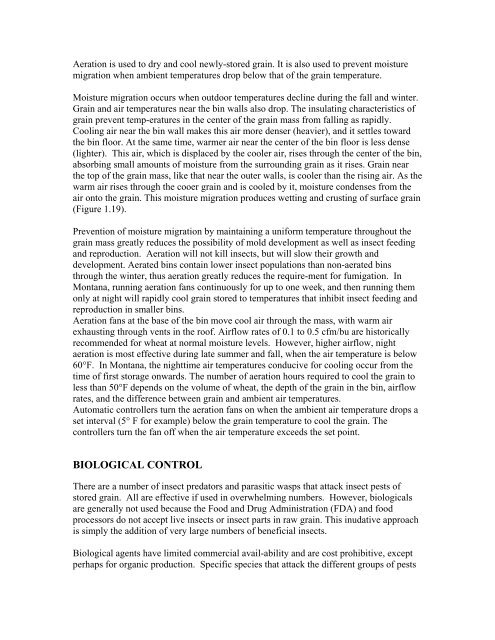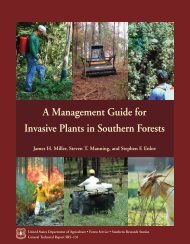Introduction - Stored Grain Pest Management Pest Management for ...
Introduction - Stored Grain Pest Management Pest Management for ...
Introduction - Stored Grain Pest Management Pest Management for ...
You also want an ePaper? Increase the reach of your titles
YUMPU automatically turns print PDFs into web optimized ePapers that Google loves.
Aeration is used to dry and cool newly-stored grain. It is also used to prevent moisturemigration when ambient temperatures drop below that of the grain temperature.Moisture migration occurs when outdoor temperatures decline during the fall and winter.<strong>Grain</strong> and air temperatures near the bin walls also drop. The insulating characteristics ofgrain prevent temp-eratures in the center of the grain mass from falling as rapidly.Cooling air near the bin wall makes this air more denser (heavier), and it settles towardthe bin floor. At the same time, warmer air near the center of the bin floor is less dense(lighter). This air, which is displaced by the cooler air, rises through the center of the bin,absorbing small amounts of moisture from the surrounding grain as it rises. <strong>Grain</strong> nearthe top of the grain mass, like that near the outer walls, is cooler than the rising air. As thewarm air rises through the cooer grain and is cooled by it, moisture condenses from theair onto the grain. This moisture migration produces wetting and crusting of surface grain(Figure 1.19).Prevention of moisture migration by maintaining a uni<strong>for</strong>m temperature throughout thegrain mass greatly reduces the possibility of mold development as well as insect feedingand reproduction. Aeration will not kill insects, but will slow their growth anddevelopment. Aerated bins contain lower insect populations than non-aerated binsthrough the winter, thus aeration greatly reduces the require-ment <strong>for</strong> fumigation. InMontana, running aeration fans continuously <strong>for</strong> up to one week, and then running themonly at night will rapidly cool grain stored to temperatures that inhibit insect feeding andreproduction in smaller bins.Aeration fans at the base of the bin move cool air through the mass, with warm airexhausting through vents in the roof. Airflow rates of 0.1 to 0.5 cfm/bu are historicallyrecommended <strong>for</strong> wheat at normal moisture levels. However, higher airflow, nightaeration is most effective during late summer and fall, when the air temperature is below60°F. In Montana, the nighttime air temperatures conducive <strong>for</strong> cooling occur from thetime of first storage onwards. The number of aeration hours required to cool the grain toless than 50°F depends on the volume of wheat, the depth of the grain in the bin, airflowrates, and the difference between grain and ambient air temperatures.Automatic controllers turn the aeration fans on when the ambient air temperature drops aset interval (5° F <strong>for</strong> example) below the grain temperature to cool the grain. Thecontrollers turn the fan off when the air temperature exceeds the set point.BIOLOGICAL CONTROLThere are a number of insect predators and parasitic wasps that attack insect pests ofstored grain. All are effective if used in overwhelming numbers. However, biologicalsare generally not used because the Food and Drug Administration (FDA) and foodprocessors do not accept live insects or insect parts in raw grain. This inudative approachis simply the addition of very large numbers of beneficial insects.Biological agents have limited commercial avail-ability and are cost prohibitive, exceptperhaps <strong>for</strong> organic production. Specific species that attack the different groups of pests
















